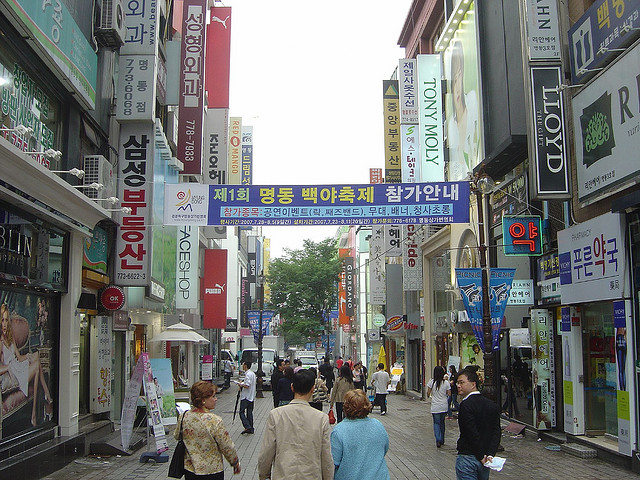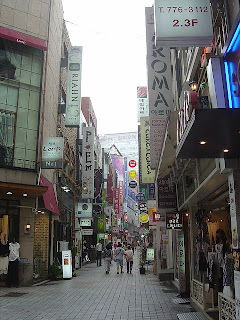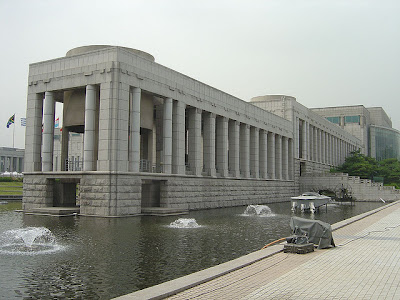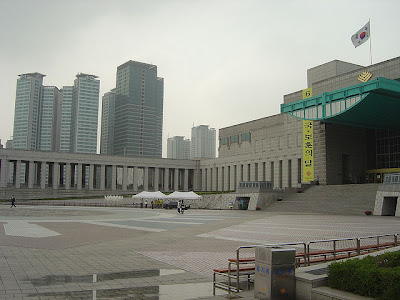Things To Do In Seoul (South Korea). Hotels, Tours, Museums & More
This article provides travel advice and things to do in Seoul for visitors. Observations, history, hotels, museums, tours and attractions.
Does Seoul have much soul?
- The North Koreans are viewed with great unease. Every male in South Korea undergoes some form of National Service, and even to this day my colleagues in Seoul told me that if North Korean Air Force takes off then so do the South Korean planes.
- In Seoul they have air raid attack drills, as due to the proximity to the border it can be minutes rather than hours from the time fighter planes take off in the North to arriving in Seoul. I even learnt that on top of the fairly ordinary, but tall, building the company I was working for at the time offices had air defense guns on the roof.
- So although I am not sure how threatened people really feel everyday, there is this underlying sense of threat that must affect the overall nature of Seoul.
It is not an especially attractive city, but neither is it unattractive.
Seoul only became the capital of South Korea in 1948, and was developed in the 1960s and beyond after damage through the Korean War. The 1970s does not seem to have left a very exciting legacy no matter what country of the world one looks at!
- Some of the books I read before going seemed to claim it had one of the highest proportions of skyscrapers in Asia but if it does they seem well hidden! It is though a very densely populated city, and ranks up there with the Tokyo and such cities. There are a lot of people packed into the city and surroundings. It is surrounded by hills that may have made the intensity even greater as there are natural boundaries to its city sprawl
There are over 10 million people living in Seoul, which is about 25% of the total population of South Korea. The Greater Seoul area though has a staggering 23 million people, making it the 2nd most populated metropolis after Tokyo.
- Although there are a lot of people, and it is supposed to be one of the most densely populated cities in the world, it did not feel quite as crowded and frantic as other big Asian (or for that matter any crowded city) and although traffic can be bad it seems there is very good public transport systems that keeps things running smoothly.
- However, despite reported attempts to improve air quality, the city is very smoggy. I was staying up on one of the hills at the Grand Hyatt overlooking the city and Hangang River that splits the city, but you could never see right across the city due to smog. Though the air did not seem that smoggy as you walked around the city.
Seoul is not as cosmopolitan a city, like Hong Kong or Singapore, and the vast majority of the residents are Korean with small Chinese and Japanese communities. As a result, it did not feel to be a very diverse city considering its size of population, which I felt is probably due to the history and sense of constant threat of turmoil with the North.
- Also, Seoul is not really on the Asian Tourist Circuit and so it is not as geared towards tourists, unless you have real interest in the more recent history of Korea. The government is now trying to promote and develop more of a tourist trade launching and promoting websites like visitseoul.net.
- However, there is not really the spread of sights and things to do that will capture tourists for that long. Colleagues who are not into history had built in a good few days before our meetings and found after less than a day even on an organized tour had seen what was on offer. Admittedly not in depth as they had not explored the museums and historic buildings just visited them.
- For me, however, visiting the relatively recently opened Korean War Memorial and Museum was one of the most fascinating and impressive days I have spent. More about this later in the blog, but this is not only a beautiful memorial (set of memorials really) and museum with row upon row of planes, tanks, helicopters and displays.
#1: Best time to go
The tourist office for Seoul recommends autumn as the best time to visit. This is because the heavy rains during the summer months of July and August have passed. This how they describe the city: “Of Korea’s four seasons, the autumn is by far the most spectacular. It as if the entire country becomes a riot of color, from the high, cloudless deep blue skies to the mountains sides blazing in red and yellow. Even Seoul, re-energized as the brisk fall weather wakes the city out of its late-summer malaise, becomes a showcase of natural delight as its sidewalks and avenues turn golden yellow with the leaves of the ubiquitous gingko tree.”
- In Summer Seoul can be very hot and very humid due to the rain, with the monsoon at this time. I was there in July and so I can confirm this! Although there is a lot happening around the riverbanks and so there can be a lot of buzz.
- Saying this, no matter what time of the year you go, one tip is not to plan to stay here too long as there is not a lot of tourists to do!
#2: Getting there and around once there.
There is a major and very modern airport in the nearby town of Incheon (about an hour from central Seoul) that is the international airport. The Gimpo Airport nearer to town is now primarily a domestic terminal. Seoul seems well served by regional airliners like Singapore Air and the Japanese Airlines in particular, and Korea has Korean Air and Asiana Air based there.
- There is a modern subway system that is very heavily used (about 8 million passengers a day) as well as buses. They all seem very efficient and well coordinated. There also seem to be loads of taxis everywhere you go, and taxis are fairly inexpensive and probably the best way to get around. Taxi drivers generally (as is true in most cities which are not very big tourists stops) did not speak English and so a good idea to get the hotel concierge to give you the name of where you want to go in Korean and your hotel as well.
- The taxi drivers seem very good natured and helpful but struggled with me trying to explain Grand Hyatt Hotel but got me there with me directing sometimes.
- One thing I will add is that I felt very safe in the city, and not sure if that was a function of the volume of people or the overall nature of the city and its people.
- The city is divided into districts and I found, with the use of the map from the hotel, that it was fairly easy to find where to go. Partly as there is not a lot to see as a tourist and so the places are easy to locate!
#3: Korean War Memorial and Museum
As I mentioned earlier, the Korean War Museum the highlight of the trip. Not only because it is so well done and so extensive and informative, but also really helps you to understand the history and its impact on the people of Korea. There are really 3 elements to the memorial:
- First, a massive set of sculptures with a set of huge spires representing North and South divide and the most amazing sculptures. Nearby to this is another sculpture of 2 men on top of a mound like building representing families torn apart between North and South.
- Second, there are the outdoor exhibits of row upon row of planes, tanks and vehicles from the Korean and Vietnam War, which you can go inside of.
- Third, there is the museum, which has long open halls on either side with the names of people who lost their lives in the war. Inside the museum are a series of halls as follows: Commemoration Hall, War History Hall, Korean War Hall, Foreign War Hall, and Army History Hall.
- See 2 videos I took at the memorial and museum: click here
#4: North Seoul Tower
This North Seoul Tower is a huge tower in Namsan Park on what is called the Namsan Mountain, though it is more of a very large hill than a mountain! Here is the place to get views of the city, but chose a clear day. The tower first was built in 1969 to enable television and radio broadcasts in the Seoul area. It was eventually opened to the public about 10 years later in 1980. Recently the tower was renovated and a light show was added which is supposed to run every night from 5PM until 11PM with various color presentations.
On the ground floor is what they call the “media zone” where you can relax and watch music video and movie commercials. There is also a playground where children can play with water and sand. Con the 2nd floor if the sky café. Then there is the observation platform where you can get 360-degree views of the city.
#5: City Bus tour
Website I am a fan of the hop-on Hop-off type bus tours with commentary. They did start one in Seoul but this seems to have been put on hold, but worth checking if it has started up again.
- There is another option that the tourist office promotes quite hard which is called the “Seoul City Bus Tour”. They described it as “the quickest, most convenient way for visitors to explore Seoul’s tourist sites. For the price of a single ticket, you can get on and off the bus as many times as you like. Courses take you past Korea’s royal palaces, though downtown Seoul’s major tourist destinations and to the city’s nighttime attractions”.
- This is fine and convenient, running every 30 minutes, but you need to then have read up and have a guidebook so you know what you are seeing and what to stop and do. But it is an efficient and cheap way of getting to the sights, and you can buy tickets at hotels or even the airport when you arrive.
#6: One Day Cultural Tour
Website. I was looking at things to do when one had limited time and on the visitseoul.net site they suggested what they called a “one Day Cultural Tour” which you could do yourself. It is a really good suggestion.
- It takes about a day and focuses on the downtown area and specifically Gyeongbokgung Palace, Insadong, Cheonggyecheon and Deoksugung Palace.
- They suggested starting at Gyeongbokgung Palace in the morning. Here you can explore what is called the most magnificent of the “Five Grand Palaces” of the Joseon kingdom. This large structure includes Geunjeongjeon, the imperial throne room, and the Gyeonghoeru Pavilion that stands on 48 granite pillars in an artificial lotus pond. There is also the National Folk Museum of Korea located to the rear of the palace complex. From the palace you get a view of Cheongwadae, the presidential residence.
- From the palace, it is a short walk over to Insadong, which is the largest market of traditional Korean art and cultural items. There are various alleyways with antique stores, stationary shops, frame stores, and handicraft and pottery shops.
- From here down to the Cheonggyecheon river, which used to be covered over and has been opened up. You follow the stream to the Deoksugung Palace, which is also one of the “Five Grand Palaces” and based on timing you may get to see one of the changing of the guard ceremonies that take place across the day.
#7: National Museum of Korea
http://www.museum.go.kr/eng/index.jsp This place is huge and has 6 permanent exhibition halls, a children’s museum, three museum shops, a food court, and a theatre. It is a vast structure, which would require at least a few visits to cover everything. The permanent exhibition halls are divided into the following sections: the Archaeological Gallery, the Historical Gallery, the Fine Arts Gallery (I and II), Asian Arts Gallery, and the Donation Gallery.
#8: Seoul Olympic Museum
http://www.seoulolympicmuseum.com/ In 1988, Seoul hosted the Olympic Games which, like most other cities hosting them was used to focus regeneration and development – in Seoul’s case for the south of the city.
- The Olympic Museum is in the Olympic Park in a three-story building. It is fairly interesting but not that unusual, the first exhibit hall is the Place of Peace where you learn the origin and history of the Olympics and the games involved. They look at Olympic heroes and the mascots of the 88 Olympics, Hodori and Hosuni. You can also watch a film at the Simulation Theater about the Seoul Olympics.
- The 3rd floor comprises of an Audio & Video library and a Document library. You can view the Olympic related documents, videos, films and other records. In the basement, you can play games of weight lifting, volleyball, soccer, skiing, snowboarding, shooting etc. I suspect as time passes the novelty and significance of the Olympics will dwindle and the museum will fade away!
Links:
- My videos and review of Korean war Memorial and Museum
- View all the photos I took of Seoul or on Flickr
- Click here to see my Grand Hyatt Seoul review, video and photos
| Seoul Korea Street |







